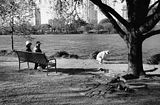A photo essay is a type of photo presentation whereby a series of photos are arranged in such a way to tell a story or evoke emotions in their viewers. A photo essay may be accompanied by a text or commentary or may not.
Just like in a verbal narrative, the photos in a photo essay may be arranged sequentially (temporally or spatially) or in any other modes of arrangement depending on the message that the author or the photographer wants to convey or the emotions he or she wants to evoke. A photo essayist may even choose to let the viewers or audience decide for themselves the order by which they want to "read" the visual narrative. In relation to the way the photos are presented, therefore, the narrative of a photo essay may be descriptive, expository, argumentative or a combination of any of them in its orientation.
The plot of a photo essay may also vary: Single, multiple, linear or flashback, and simple or complicated. However, considering the nature of still photographs, it may, in my opinion, be a little bit difficult to have multiple plots in a photo essay.
A photo essay may concentrate on events, places, or people. Regardless of its subject, a photo essay strives to present the essence of the subject that becomes its theme.
The following is an example of photo essay. I decided not to include a commentary on this one.
Text and pictures by Eki Qushay Akhwan, all rights reserved.
FLYING FOX



Sunday, December 28, 2008
What Is A Photo Essay?
Friday, December 26, 2008
Photo Exploration # 33: Street
Monday, December 22, 2008
Saturday, December 20, 2008
Travel Photography # 04: Crossing The Golden Gate (A "Photo Scavenger Hunt" Post)
Photography is my passion. But there are also other things that I enjoy doing: Travelling, reading, gardening, and teaching.
Teaching is of course my profession, but more than that it's a profession with a passion. I've tried other jobs before and even though they were good and well paying, none was as satisfying - and addictive - as teaching. I'm glad I chose this profession and I'm proud to be a teacher.
And here are the photos for my participation in this week's "Photo Scavenger Hunt":
Photo 1: That is me - the one with that camera backpack - and my wife's colleage on the Golden Gate bridge. He used to study in California and knows a lot about San Francisco. He tried to explain to me about a few things we saw from the bridge. My wife took this photograph. She's not very much into photography. In fact, she often says that she can't use a camera! She's very good at other things though - she's very smart and, apart from photography, she can do a lot of things better than I can.
Photo 2: Here is my wife and me, posing at the Golden Gate park with the bridge and the San Francisco bay at the background. Her colleague took this photograph.
These photographs were taken last year (2007) on our trip to three US cities. It was her business trip. I was only a chaperon.
Oh, and here is a 42 second video clip of the bride crossing. Enjoy!
Friday, December 19, 2008
Tuesday, December 16, 2008
Travel Photography # 03: Advertising God on the Street of San Francisco

Last year I accompanied my wife for a week-long marketing trip to three US cities. San Francisco was our first stop. It was my second visit to San Francisco.
I always like this city even before I visited it. I had read a lot about it and dreamed of visiting it long before I actually had a chance to visit it. The first chance to visit this city came in 2005 when I was studying in the US. Just like what I had read, SF was really a wonderful city and I fell in love it. So the second visit I made to the city last year was like visiting a long time friend whom I had not seen for quite a while.
I like SF's breezy and cool air (eternal spring?), warm sun, the hilly landscapes, wonderful architectural heritage, its astonishing varieties of food from every corner of the world; but most of all, I like its friendly and liberal atmosphere. People on the streets seemed to be much more ready to smile and were less inhibited to speak to strangers and visitors like myself than any other cities I had visited in the US.
The streets are very lively too. The Chinatown has somewhat familiar feel about it. The sights and sounds are just like what I am used to at home. I guess it's the common Asian experience we share with the Chinese people. Other streets ... feels like ... well ... the American melting pot: African American, Asian American, Latino American ...
What happened in this photo was, I think, quite unique. I've never seen it anywhere else. This man of church was advertising God's love - on the street!
Sunday, December 14, 2008
Travel Photography # 02: Vietnam War Memorial, Washington D.C.

I visited Washington, D.C. twice, first in summer 2004, and then in spring 2005. I took this photo in my second visit.
Washington, D.C. has many monuments and memorials, of which quite a few are dedicated to the nation's memories of the different wars it has been involved throughout its history. While other war memorials I have visited in D.C. are solemn and have the appropriate respectful atmosphere to the fallen soldiers of the wars, none of them could inspire in me the chilling feel of the Vietnam War Memorial.
The thousands of names inscribed on those black marble walls should remind us how cruel wars are - both to the persons whose names are written there and their families, and to those whose names are not and will never be written anywhere because they are just "too ordinary" to make it into a historical document of some sort.
Friday, December 12, 2008
Photo Exploration # 30: Backyard Photography
Thursday, December 11, 2008
Monday, December 8, 2008
Photo Exploration # 28: Homo Urbanicus 01

What is homo urbanicus?
Homo urbanicus is a type of human species (homo sapiens) who live in a special kind of environment of dense human-made structures commonly called the city.
In many ways homo urbanicus are not very much different from homo sapiens, but they do have their own unique traits. They, for example, are so used to being encased (enclosed?) in structural limitations that they see these structures as being a normal part of their existence. In fact, they love these structures so much that they think they can't live without them: They homes are typically small, cramped structures where they put a tube window called television to help them see the "real" wild world. When they are not working, they can sit for hours in front of this tube marvelling at the outside world. Most of their jobs, by the way, are conducted in walled structures called "office" - a place where they spend more than half of their lifetimes to earn their lives/living/livelihood. When they get bored with home and office work, they "go out". But their outings are not really outings. They usually go into another kind of walled structures called "malls," "movie theaters" or any other similar structures where they can get entertained.
Well, this short prose may not be about photography per se, but at least it's an attempt to verbalize the experience of the picture.
^_^
Text and picture by Eki Qushay Akhwan
Sunday, December 7, 2008
Photo Exploration # 27: Self Portrait

In the world of art, self portrait is often defined as an attempt by an artist to depict oneself in his/her own work of art. This depiction can be an exploration of the artist's own pysche or just a self modeling.
Many artists of different media have done one kind of self portrait or another. Although the making of self portrait is not new (ancient Egyptian of the 14th century BC are known to have practiced this), the real self portrait in the sense of identifiable self-portrait "that is a separate painting,[and] not an incidental part of a larger work" is often considered by many not to begin until the fifteenth century with the work of Jean Fouquet(Self Portrait, c. 1450).
Friday, December 5, 2008
Photo Exploration # 26: Hong Kong Airport Roof Structure

I took this photo when we had a stop over in Hongkong on our recent trip to the United States. There are two things that fascinated me about this airport: The roof structure and its optimal use of natural lighting.
As I said before, I somehow have a special affinity to geometry. Subjects with geometrical shapes always fascinate me.
Tuesday, November 25, 2008
Photo Exploration # 25: Twisted Time

In a digital world, anything can be twisted, including time and, of course, this photograph.
Can a digitally manipulated image like this still be called photography? Many would say YES. They'd say that as long as the basis is still a photograph - an image created by a camera - a digitally manipulated image should still belong to photography. There are others, of course, who disagree. Call them purist or whatever, they do have their own valid arguments about what they believe photography should be.
Monday, November 24, 2008
Photo Exploration # 24: I still have yet to understand

What's the limit of an exploration?
I'd say, it's understanding. For as long as we have not reached a desirable and satisfactory understanding of what we set out to explore in the first place and of the answers found that have since generated more questions, that exploration shall not come to an end. Exploration in this sense, therefore, is the essence of our life's journey on its own. It is a never-ending quest to understand, to quench the thirst we were born with.
Our exploration - our life's journey - may consist of smaller, more manageable sub-explorations. Together, they form a stream - a huge stream - of life energy that keeps us moving, living. When that stream stops flowing, that is to say when our quests for answers have stopped, then that's when life ends.
This photo is part of that smaller sub-exploration of mine of the wonder of the visual world; how I come to like what I see, what moves me to cast the spell of camera magic and freeze it in a frame, and how that interplay of the inner and outer worlds in that simple act of pressing the button of the camera gives me so much satisfaction (or dissatisfaction) to me.
Please do forgive me for these visual and verbal ramblings ...
Eki Qushay Akhwan
Sunday, November 23, 2008
Photo Exploration # 23: Feet and Stillettos

Feet and stillettos ... two things that go together.
As you can obviously see, this photo is heavily cropped at the top and a little bit at the bottom. I did it to get rid of the extraneous visual elements that will distract attention from the main point (the point of interest) of this photograph. The compositional simplification I did to this photo, I think, helps accentuate the feet (both of the girl's and the chair's), and hence articulates the impact I want to achieve in presenting the subject.
Now the question is, how much cropping are we allowed to perform in photography?
There are no exact guideline to this. Some photographers, like Henri Cartier-Bresson, simply oppose after-the-fact cropping as, according to him, it would destroy the "geometrically correct interplay of proportions" of the original scene. Many other photographers, of course, have more linient attitude about cropping.
Generally speaking, however, cropping is a very useful way of enhancing a photograph's composition. It does so by removing unwanted or distracting elements, correcting compositional balance, or hiding/covering a framing mistake. It also helps create the visual impacts you want with your photograph.
Text and photo by Eki Qushay Akhwan.
Saturday, November 8, 2008
Photo Exploration # 22: Small Things and Affinities to Visual Elements

To me it's still a mystery why some people (read: photographers) are more attracted to a particular type of visual stimuli. Some of them obviously have more affinity to landscape, some to human expressions or lines and geometry, and others to other visual elements such as light, colors, textures, and other more subtle hues of image-making that not everybody can even "see".
I understand that people with greater visual intelligence pay attention to all those elements. But evidence also shows that their attention is not directed equally to every one of them.
As a photographer, I have learned to feel comfortable with different subject matters with my camera. I can do landscape as comfortably as portraiture, architecture and abstract as dexterously as street photography, but when it comes to visual stimuli, I think lines and geometry are what I am attracted to the most. My reactions to them are almost always spontaneous - it's like I can see them even when they are not tangibly manifested.
By the way .........
I "discovered" the above photo at the reception desk of a car and motorbike wash. The encounter was brief and my reaction to the visual stimulus was spontaneous. As I would normally do in such an encounter, I explored the scene, taking several pictures of it without thinking much. I did not know why I was attracted to this object, but when I saw the results, I think it's mostly the lines, the curves, and the geometry of it that had triggered my instinctive photographic reaction in the first place.
Wednesday, November 5, 2008
Photo Exploration # 21: Street Photography?

Is a moment snapped from the street (or public space for that matter) necessarily a street photography?
Convention has it that street photography is (should be):
- a photo taken at a public place (of which the street is part);
- a photo that focuses on a candid action of a human being or human beings; and ...
- ???
I wrote about it once here. But is this one really a street photography? What makes it so? Or not so?
Friday, October 31, 2008
Photo Exploration # 20: Platonic Reality

I said, whatevery moves me.
Like a hammer striking hard at the senses, the scene moved me. I tried to capture it from different angles but, to my frustration, none seemed to work out. Such is the elusive power of photographic reality. Light was fast fading - and so was this fleeting drama of the shadow.
Platonic Reality, the title of this post, is inspired by the Cave Allegory or Cave Metaphor that Plato used in The Republic (Book 7, 514a - 520a), in which he narrated a fictional conversation between Socrates (his teacher) and his brother Glaucon. In the dialogue, Socrates introduced the idea that what many people take to be reality could in fact be just an illusion.
Confined from birth in a cave and forced to face the wall where shadows of the "real" things are projected, the prisoners who inhabit the cave (that's us?) have only seen shadows all their lives and hence they have come to belive that the shadows are real and that they are reality.
Saturday, October 25, 2008
Meeting The "Photo Scavenger Hunt" Thematic Challenge: Things That Go Fast
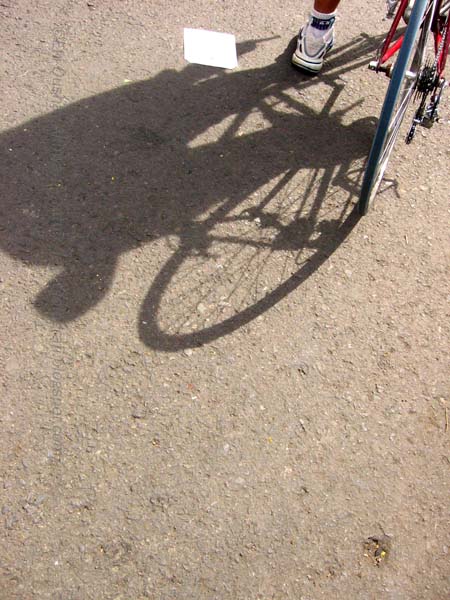
Every now and then photographers need to create a challenge (in the form of a project of some sort) or meet a challenge posed by others to hone their photographic skills and keep their creative powers alive.
My post today is about meeting that kind of challenge.
Photo Scavenger Hunt is a photographic weekly thematic challenge initiated by a photo blogger friend of mine, Carrie Hayes of View of You Photography. For this week, the theme is "things that go fast" - and here is my interpretation of it.
How fast is fast? Well, I think that depends very much on what yard stick .you're using. A car can be fast, but it would seem slow compared to a rocket, for example. A bicycle may be slow when compared to a car, but it definitely is faster when compared with walking.
Fotografer kadang-kadang perlu menciptakan tantangan atau menjawab tantangan yang diberikan oleh orang lain untuk mengasah kemahiran fotografi dan kreatifitasnya.
Thursday, October 23, 2008
Monday, October 20, 2008
Photo Exploration # 18: Urbanites 01
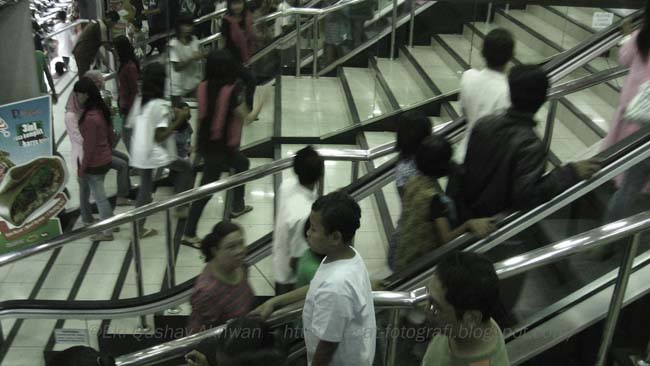
JAGAT FOTOGRAFI received KREATIV BLOGGER AWARD from a fellow photo blogger Laetitia of Malta Magic. Thanks a lot, Laetitia.
Friday, October 17, 2008
Photo Exploration # 17: Construction
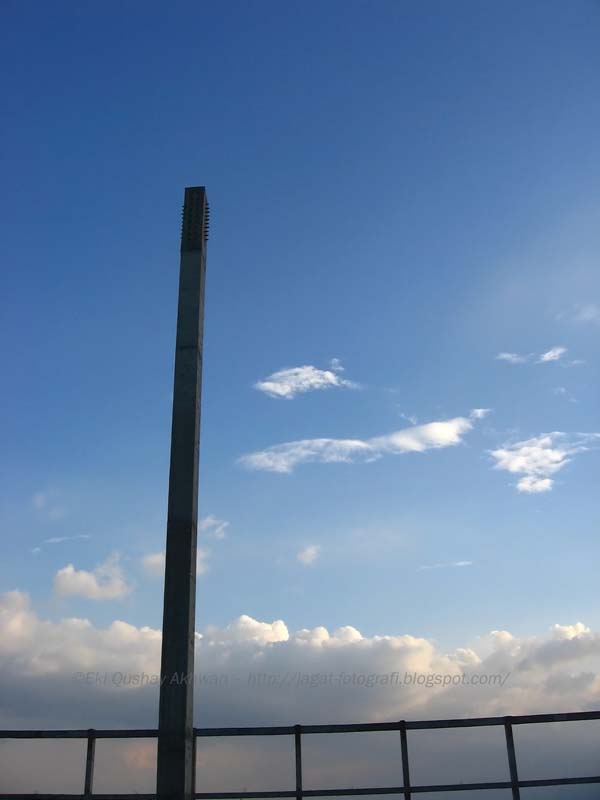
My participation for this week's theme of Photo Scavenger Hunter: Construction.
This concrete skeleton is going to be an indoor tennis stadium of the Faculty of Sports Education of the Indonesia University of Education, Bandung.
Monday, October 13, 2008
Photo Exploration # 16: Whatever Moves Me ...
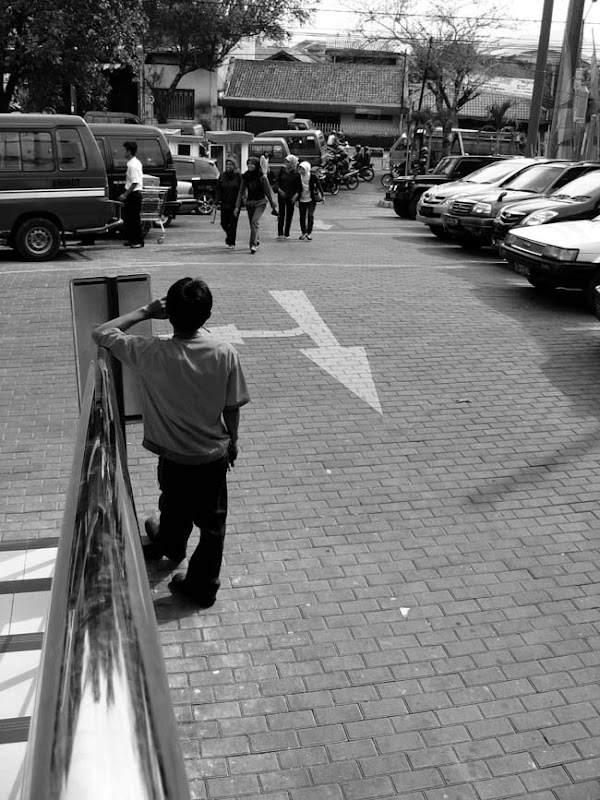
The Creative Processes Within:
I take photos of whatever moves me. Sometimes they are good, sometimes not so good, but very rarely are they bad. No, no, no, ... I'm not trying to say that I never fail. I certainly have had my own fair share of bad photographs if the "accepted" norms of what makes good and bad photographs are used. What I mean by "I rarely have bad photographs" is that no matter what a judge in a photography contest or the viewing public would have said about my photographs, I would still feel good about them if I feel some sort of satisfaction when I took those photos. And that kind of satisfaction comes from the good feeling I feel about following my "instict," following what "moves me from within".
I can't always name or explain what that is that makes my visual instinct tickles when that is happening. But the photos usually speak for themselves, after they were created. Quoting them (the photos), sometimes it is the convergence of lines and geometrical elements that make a pleasing or curious composition. At other times, it's a fleeting moment that begged to be frozen in a frame, or the appealing plays of light and shadows, or colors striking the visual cords within. Whatever happens, I don't usually have an overt consciousness about what the pictures will "speak" about.
Having said all that, however, I must also admit that things have not always been like that. There were times in my love affairs with photography when my visual intincts were mixed or confused with my conciousness of who the audience of my photographs would be. I tried hard to make "good" photographs that would somehow please my audience (imagined or real) by conforming to the accepted norms about what a good photograph should be - in the choice of subjects, the rule of composition, and other technical tids and bits. But did I feel happy? Successful?
Sometimes, I did. But the constraints the conscioiusness I had about my audience placed upon my "creative shoulders" felt too heavy and made me feel disoriented about where I wanted to go with my photography. So, I had to let it go. It (losing my audience and audience's approval) was not easy, but I'm glad I did it. Now I feel freer to pursue whatever moves me from within.
October 13, 2008
Eki Qushay Akhwan
Sunday, October 12, 2008
Photo Exploration # 15: Colors
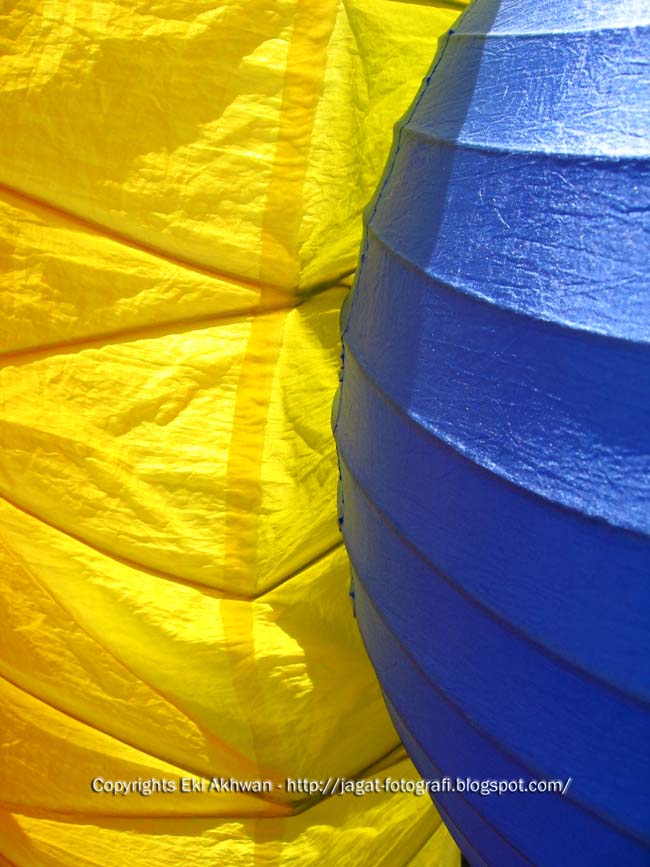
"There is a clear difference between a photograph in which there happens to be colour, and one in which the colour works to make the image what it is."
(Freeman, Michael.Digital Photography Expert: Colour. Cambridge, England: ILEX, 2005)
The legitimacy of color as a subject of a photograph has been debated among photographers for a long time. For those who are against it, the concentration on "beautiful colors in pleasing relationships" is considered to be one of the two "categories of failure" of color photography (Szarkowski in Freeman, 2005: 133). Though "pleasing," an image that makes color its (primary) subject is considered by some art critics as a photograph "in search of a subject," or a "formless" photograph (op cit.).
This is the Indonesian version of the above text:
Warna sebagai subjek foto yang sah telah lama diperdebatkan di kalangan para fotografer. Bagi yang tidak setuju terhadap warna sebagai subjek foto, konsentrasi pada "warna-warna yang indah" dianggap sebagai salah satu dari dua "kategori kegagalan" fotografi warna. Meskipun tampak "indah," sebuah foto yang menjadikan warna sebagai subjek utamnaya dianggap oleh sebagian kritikus seni sebagai foto yang "kehilangan subjeknya" atau foto yang "tak berbentuk".
This is what the above photograph looks like when it is desaturated. The "pleasing" effect, as you can see, is gone.
Saturday, October 11, 2008
INTERNET SERVICE PROVIDER REVIEW: How Bad is INDOSAT M2?
I know this blog of mine is a photo or photography blog. But today, with this post, I will have to use this medium for something other than photography. So, first my appology to you, my audience, for this unexpected detour. I promise this will not happen very often, and, as it should, you will still be seeing more photos and articles on photography here than this kind of irrelevant posts.
Blogging, and especially photo blogging, as I am sure you are all aware of, requires a reliable and fast internet connection. Without reliability and speed, photo blogging will just be a pain in the a**, as without them, it will take forever to upload a photo, let alone photoblog surfing or photoblog walking.
This was the first reason I had for my decision to switch my internet connection from Telkomnet Instan (by Indonesia’s PT. TELKOM) dial up to Indosat M2 wireless 3G. Portability (or mobility?) and speed seemed to be a great thing to have in addition to budgeting. With Telkomnet Instan, whose charge is time based, I often could not have control about how much money I would have had to pay by the end of the month. (Blogging is indeed an exciting thing and, I have to admit, a sinfully addictive activity that time seems to be flying when you are at it.) With byte-usage-based charge in monthly fixed rate Indosat M2, I thought, was a better choice.
Well, now I have proven that to be wrong. Not only is Indosat M2 bad, it is insanely worse than bad that I’d suggest you think it over many times over before you even consider of signing up for its service.
Let me describe how bad it is according to my own experience. Since I signed up for its internet service – which is by the way vigorously advertised as being fast, reliable, 3.5 G mobile internet connection – I’ve only got what was promised approximately 20% of the time. The rest 80% of the time or so, the service was just purely crap. With the speed of approximately 30 kbps on average, the internet connection provided by Indosat M2 is was below that of the normal speed of even a dial up.
I have brought this problem up several times with Indosat customer service officers (CSO). At first, I believed and followed all their technical suggestions and advice: setting this and that from my computer, etc. They worked sometimes, but failed most of the time. I kept knocking at their door and asked why I did NOT get what they promised. By this time, the CSO started to come up with a different kind of suggestions. They blamed the location from which I accessed their service. They said that since I accessed their service from what they called “a border area”, the quality of the service was not optimal. Almost apprehensively, I bought that excuse. I thought there was nothing I could do about it. I live in the subburb, and that’s the culprit. I could not blame them.
But then I began to observe this phenomenon: Even in my office, which is reasonably located within the city’s borders, I rarely get the fast and reliable internet connection promised by Indosat M2. During the busy time, the situation is as frustrating as when I access the connection from home. So, I began to think that the “border area” explanation was not really the real reason for Indosat M2 bad services.
I also observed that sometimes I could get reasonably good and fast connection from home (which according to Indosat CSO was in the “border area”), that is when I access their internet services very early in the morning (2:00 AM and after). Also, during the last Ied Al Fitr (Idul Fitri) holiday season, I generally did not have the same frustrating problem I had been experiencing. At these times, the connection was as fast as 3G (UMTS or HSDPA) even with only one or two bar signal that I got.
All this evidence leads me to the conclusion that the problem I have been having was not due to the fact that I lived in a “border area” or because of some technical issues with the setting in my computer as had been explained by Indosat’s CSO. It must be because of the shared bandwidth that Indosat M2 system is using. As a result of their vigorous campaigning, many new customers have apparently signed up for the service. This, unfortunately, was not compensated on their part by improvements in their facilities (technical, bandwidth, etc.). Hence, the worsening service that, in my experience-based opinion, is bordering with fraud. If things continue the way it is now, Indosat M2 can be considered as having committed fraud, i.e. not keeping the promises it made in its advertising campaigns to its customers.
Tulisan ini adalah REVIEW LAYANAN INDOSAT M2.
Berdasarkan pengalaman langsung konsumen seperti yang dipaparkan dalam tulisan ini, layanan internet Indosat M2 secara umum sangat buruk. Layanan internet cepat seperti yang dijanjikan dalam iklan-iklan Indosat M2 tidak terbukti. Analisis yang dilakukan penulis menunjukkan bahwa layanan yang buruk itu kemungkinan besar disebabkan karena peningkatan jumlah pelanggan tidak diimbangi oleh Indosat M2 dengan penambahan bandwidth yang sewajarnya, sehingga bukan hanya kecepatan akses menjadi sangat lambat (lebih lambat dari kecepatan akses internet dial up), namun juga sering menjadi “stalled” (macet) – kondisi dimana meskipun sinyal tampak kuat (5 bar), browsing tidak dapat dilakukan karena transfer data NOL atau nyaris NOL.
Ketika saya menulis artikel ini, saya sudah menunggu jawaban dan penyelesaian masalah atas pengaduan yang saya lakukan bertanggal 3 September 2008 (lebih dari sebulan yang lalu) dengan nomor pengaduan 08091444093 yang hingga saat ini belum dijawab atau diselesaikan oleh Indosat. Perlu diketahui juga, sejak saat itu saya telah beberapa kali lagi menghubungin CSO Indosat M2 (terakhir malam ini, di mana CSO yang menerima telepon mengkonfirmasi bahwa memang masalah tersebut belum dijawab dan/atau ditangani).
Dengan pengalaman buruk yang saya alami, saya hanya bisa menyarankan, pikir seribu kali sebelum tertipu oleh iklan-iklan Indosat M2. Janji-janji dalam iklan-iklan itu tidak terbukti!
By the time I wrote this article, I have been waiting for an answer and/or settlement of the complaint I logged in with Indosat M2 on September 3, 2008. I have been calling them serveral times since then, the latest of which was tonight, in which the CSO handling my call confirmed thatr the problem was not fixed and settled yet.
With all this disappointment, I can only suggest you think twice or more to use Indosat M2 as your choice for internet service provider. Indosat M2 service is CRAPPY!
Friday, October 10, 2008
Skywatch Post 01 (NT)
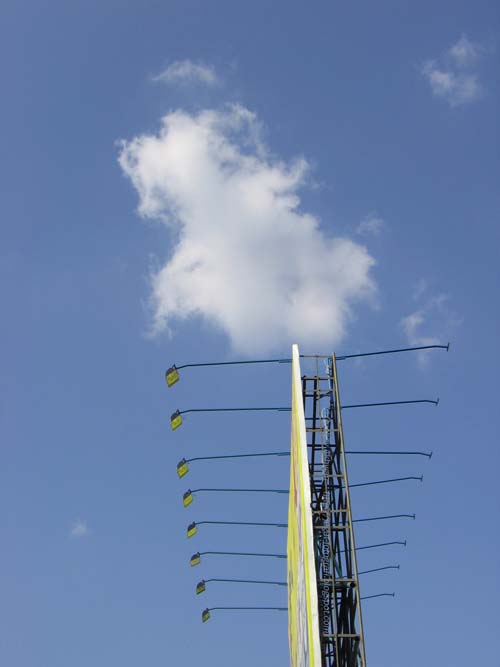
This photograph is for this blog's participantion is Skywatch Friday. To see other participants' photographs, please check here.
Thursday, October 9, 2008
Street Photography # 4: Children's World
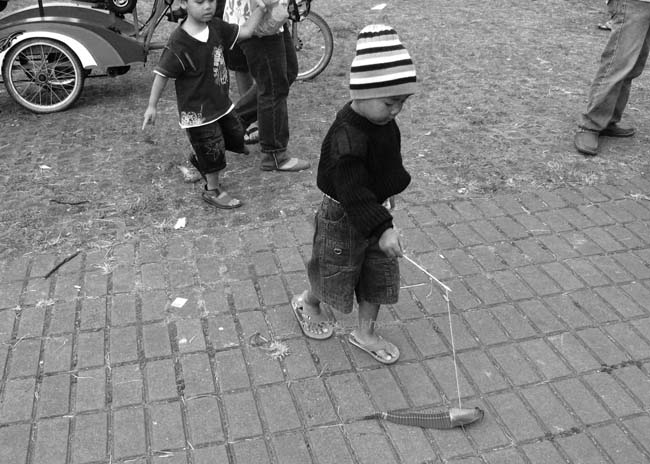
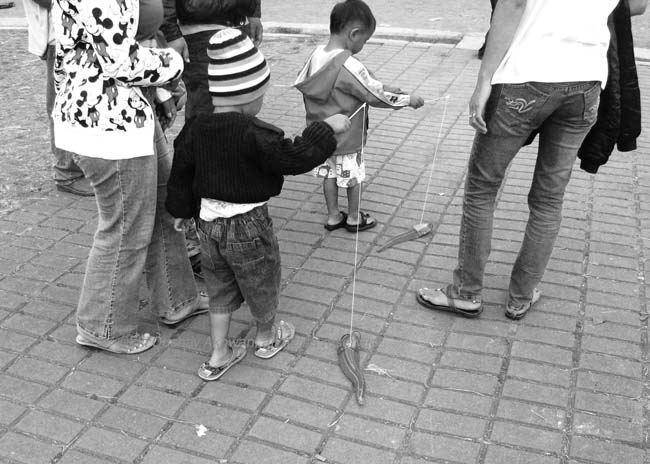
Children live in their own world.
It is not ours.
Ours is a world of thoughts and consciousness,
of works and complex interplay,
theirs is a world of imaginations,
of freedom and play.
We teach them to become us.
Do we not want to learn to become them?
to be imaginative,
to be at play and enjoy,
to be free and feel the joy?
Eki Qushay Akhwan
Tuesday, October 7, 2008
Monday, October 6, 2008
Sunday, October 5, 2008
Saturday, October 4, 2008
Thursday, October 2, 2008
Tuesday, September 30, 2008
Saturday, September 27, 2008
Photo Exploration # 8: Irregularities
Thursday, September 25, 2008
Photo Exploration # 7: Time for A Football Fan and Photography Addict
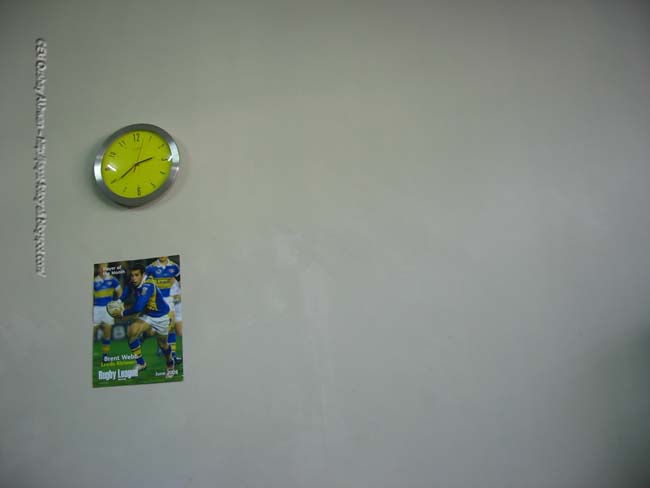
In many ways, a football/soccer fan and a photography addict are the same. Their lives are saturated with the objects of their fascination.
I took this photograph in the classroom of my one-on-one tuition student of Bahasa Indonesia as a foreign language. My student, a British national, is a heavy weight football fan. His teacher, that's me, is a photography addict. This is what happened when we met in the class one day in one of our twice-a-week sessions.
Can you see which team is his favorite?
Wednesday, September 24, 2008
Tuesday, September 23, 2008
Monday, September 22, 2008
Inhibition and Audience Effect: What Happens When A Photographer Loses Interests in His Photography?
Text copyrights Eki Akhwan, all rights reserved.
A photographer friend of mine is having a serious problem right now. After years of love affairs with photography, he – of late – feels that he can’t “make” photographs anymore. The emphasis here is on the word “make” as opposed to the word “take,” like in taking pictures. He can still snap pictures, of course, which is quite easy and of which anyone with a camera can do. The paralysis that he feels is of making good photographs, one thing that he has been doing very well for many years as a photographer. He is a champion in many ways and, I can comfortably say, many of his works are exemplary and a source of inspiration for my own works. Needless to say, I can feel his desperation. I too would feel the same if out of a sudden I should suffer the same kind of paralysis. Like I said somewhere in one of my postings before, making photograph for a photographer is like a lifeline. Denying a photographer the chance to make photographs is like taking away his source of life energy.
Now, what’s happening here?
Skills-wise, there is no way that he has suddenly lost the ability to make good photographs, much less his talents and visual dexterity. Considering that he is physically healthy too, I can only conclude that the cause of his detriment must be psychological. It could be from mental or physical exhaustion, which by the way, he thinks it is. I, however, tend to rule this out as, in my own experience, photography - for photographers – one of the best ways to overcome those things. That leaves me searching for other explanations to understand why this curious phenomenon could happen.
A little library research I did over the past few days revealed that this phenomenon may have something to do with what in psychology is called inhibition, i.e., a kind of interference with behavioral response to a stimulus. More specifically, what my photographer friend is currently experiencing could be categorized as a symptom of reactive inhibition of the social kind.
Reactive inhibition is a tendency towards a weaker response to a stimulus that is caused by a long stretch of practice or activity. In my friend’s case, his long of practice and activity in photography has, over time, made him lose some degree of acuity in his response to visual stimuli that he needs to produce this photographs. From this distance, his inhibition seems to be socially motivated and, more specifically, it comes as a result of what psychologists believe as “audience effect”. Put in a plain language, this simply means that my friend’s photography is being paralyzed by his own perception and expectations of his (passive) audience and his judgment of his own ability to meet those expectations.
If the above explanations still somewhat sound too theoretical, this is how it works. As someone who is very good at what he does (i.e. photography), he has somewhat achieved a standard of his own of the kind of photography he makes. The same goes with his audience who has come to expect only high quality photographs from him, which by the way has also become his perceived idea of his audience. This situation puts a lot of constrains in him. He can not go down in standard and yet to go up he would need a lot more energy and dedication than what he has already spent. Together with his decreased response to stimuli that resulted from his long stretch of engagement in photography, this can be too much to handle, thus the paralysis.
There are at least two options one has to overcome the situation. First, he has to learn to let go of his social inhibition, that is relieving himself from the kind of burden he has about the quality of his photographs and his perception of his audience expectations. Flowing with what I would call “photography instinct” is advisable. He should not push himself too hard. Just take or make photographs of whatever moves him visually, and worry about the quality later. Second, he has to find a community of appreciative audience who can take him for whatever he is – his strength as well as his weaknesses. Encouraging comments from a community like this could work magic to regain his confidence and self-esteem as a photographer.
I hope this article helps those who have similar problem.
Sunday, September 21, 2008
Photo Exploration #4: Light and Geometry
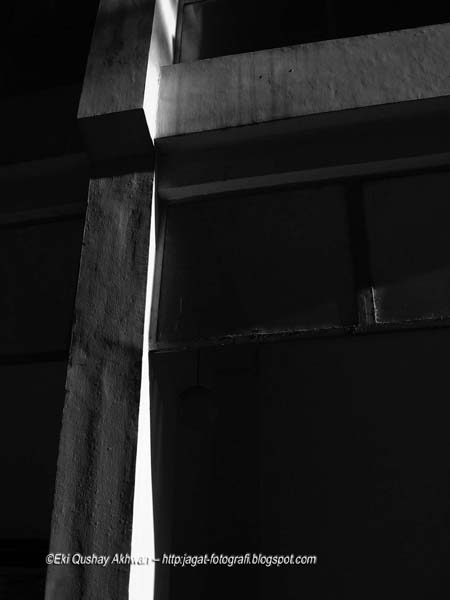
Photography is about light: How we respond to light, how light falls on objects, how it creates illusions of space and depth, and how we capture it on our medium.
Text and picture ©Eki Qushay Akhwan – http://jagat-fotografi.blogspot.com/
Saturday, September 20, 2008
Photo Exploration # 3: Shadows, Light, and Textures
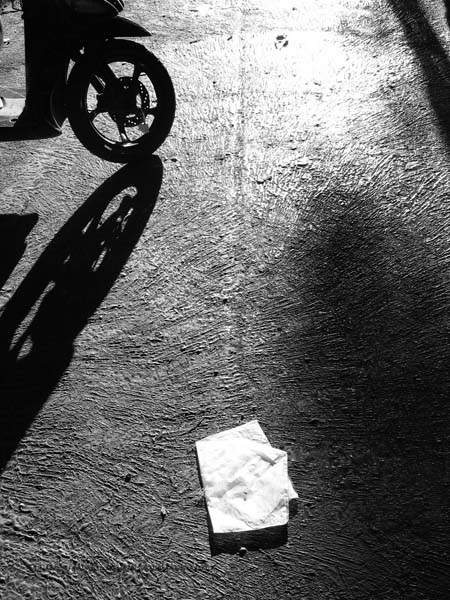
In photography, shadows, light, and texture are always interesting elements with their own visual impacts. We don't need to go far to find them. We pass by them everyday, often ignore them for their "ordinariness", and - as a result - miss the invaluable photo opportunities they often present. Exploration, as I said earlier, is about looking carefully and discovering the extraordinary in the ordinary.
Here is my third post on the exploration of the day to day phenomenon that we pass by in our daily life experiences: Light, shadows, and texture. I took this photograph at the parking lot of my office building one sunny late afternoon when the warm, directional light striked ever so beautifully and touched my mind's eye and moved my finger to press the shutter.
Friday, September 19, 2008
Photo Exploration #2: Of Interview and Carpe Diem!
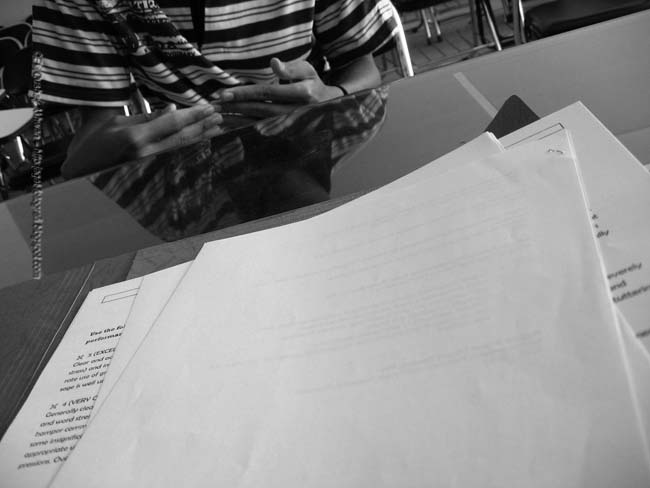
When I said about exploring our day to day environs, I didn't mean to say that it was just things or objects, but also people with whom we interact.
This is what I did yesterday. Opportunities to make photographs do present themselves even when we are busy doing other things. It's our decision whether or not to grab them. Carpe diem, seize the day!
Thursday, September 18, 2008
Photo Exploration #1: Nature and Geometry
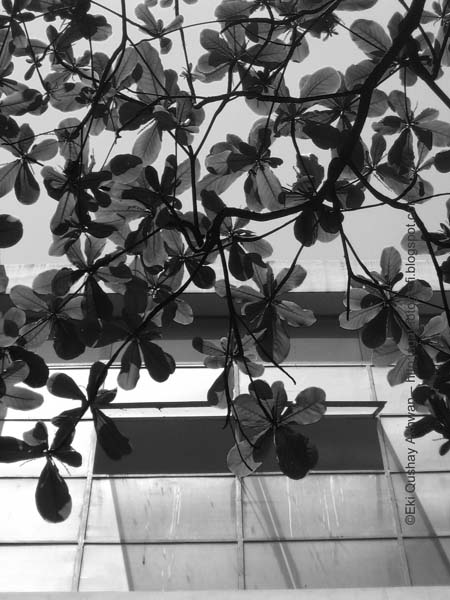
As I said in the previous post, I feel that it was necessary for a photographer or photography enthusiast to keep honing his/her sensitivity to the visual stimuli around him/her. One way to do it is by always having a camera at his/her disposal and exploring the environment closest to him/her, e.g. home, place of work, the streets he/she passes by everyday, etc.
Our daily environments may look ordinary and uninteresting because we are so used to them. However, if we really look and observe, I am sure there are a lot of hidden visual treasures that we can discover. Here is the first of what I hope to be a series of regular posts on this blog of my visual exploration of the near and ordinary - of places that I pass and see everyday.
These windows and the glowing leaves of "ketapang" tree in front of my office complex got my attention one sunny afternoon. The first thing that moved me about this scene was the glowing leaves and the hard shadows that fell on the glass windows. It's an intinctive shot. I like the rigid geometric lines of both the windows and the shadows and the "flowing" natural lines of the leaves. I explored the scene from different angles, trying to find the best composition I could get that combine the natural beauty and the beauty of the geometric lines. This photograph has one of the angles that I think best captured my vision of harmony between nature and nurture, that of leaves and tree branches and the man-made architectural geometry.
Text and picture copyrights ©Eki Qushay Akhwan, all rights reserved.
Unless otherwise stated, the articles and photos in this blog are the copyright property of Eki Qushay Akhwan. All rights reserved. You may NOT republish any of them in any forms without prior permission in writing from Eki Qushay Akhwan.
Kecuali disebutkan secara khusus, hak cipta atas tulisan dan karya foto di dalam blog ini ada pada Eki Qushay Akhwan. Dilarang mempublikasi ulang artikel dan/atau karya foto di dalam blog ini dalam bentuk apapun tanpa izin tertulis dari Eki Qushay Akhwan.






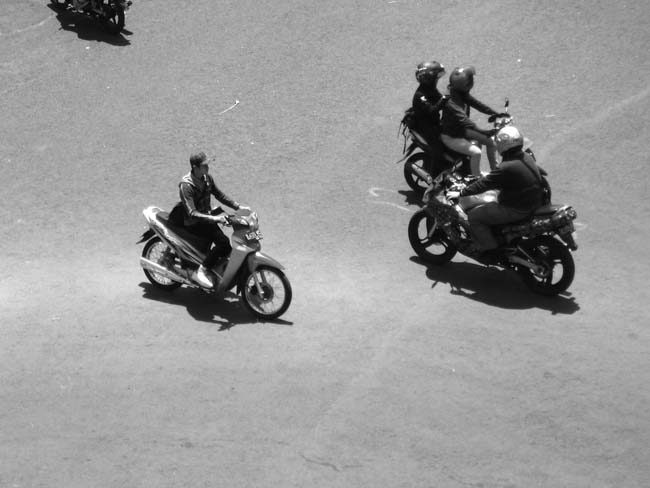


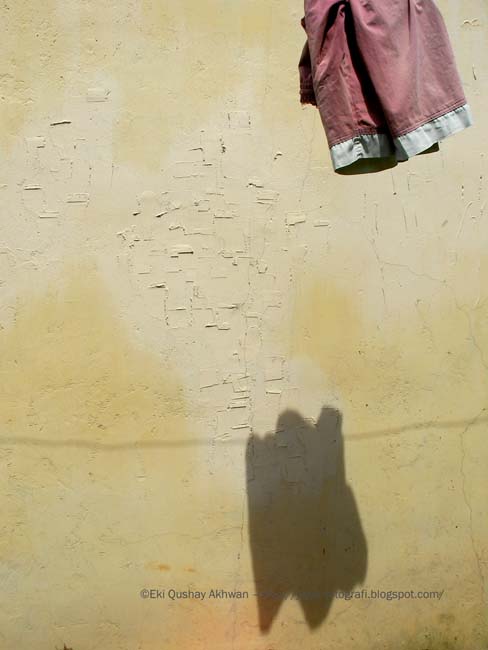
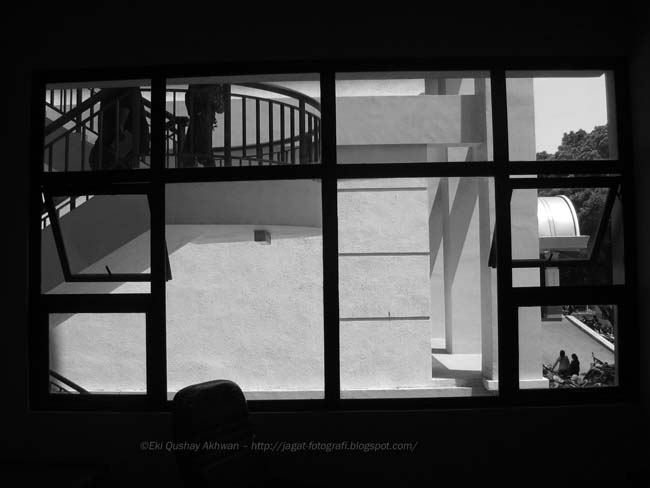
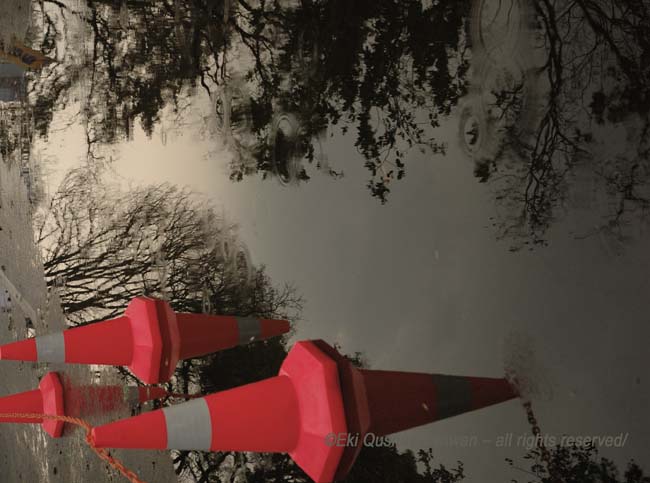
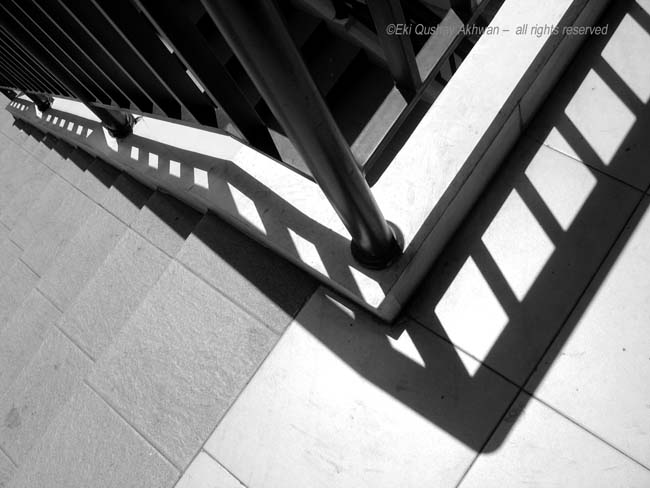
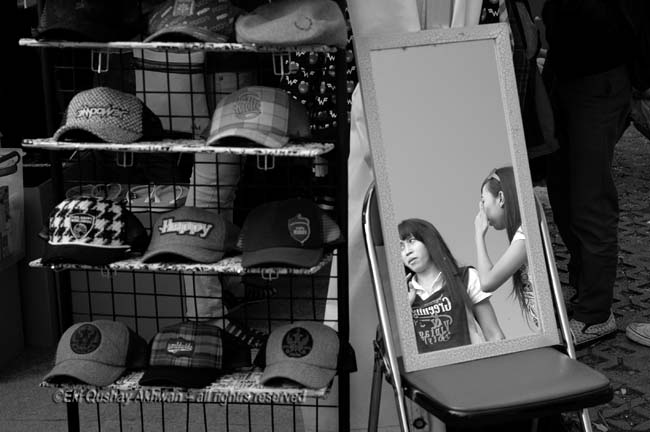
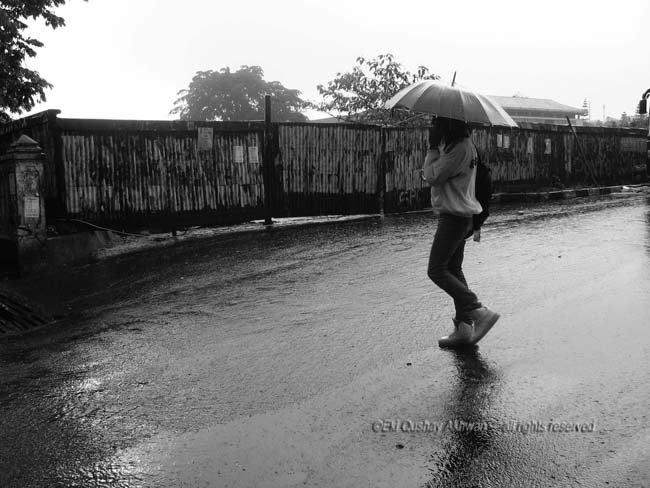
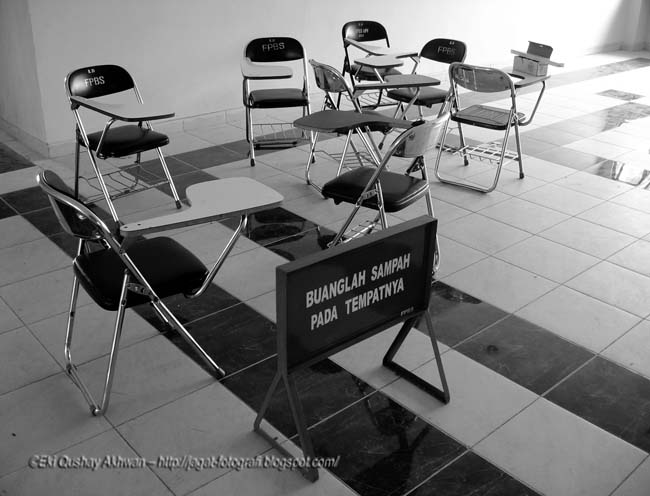

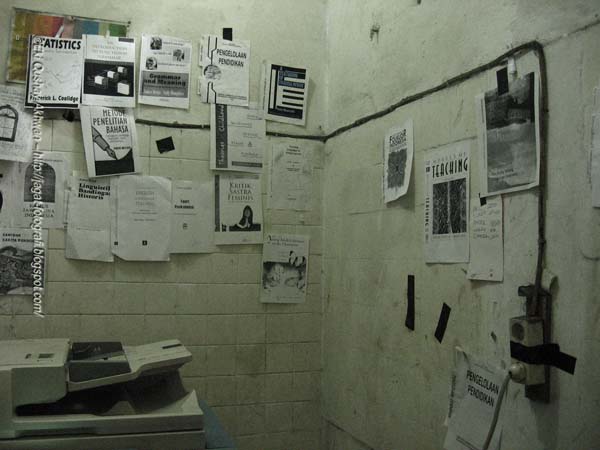







.jpg)


